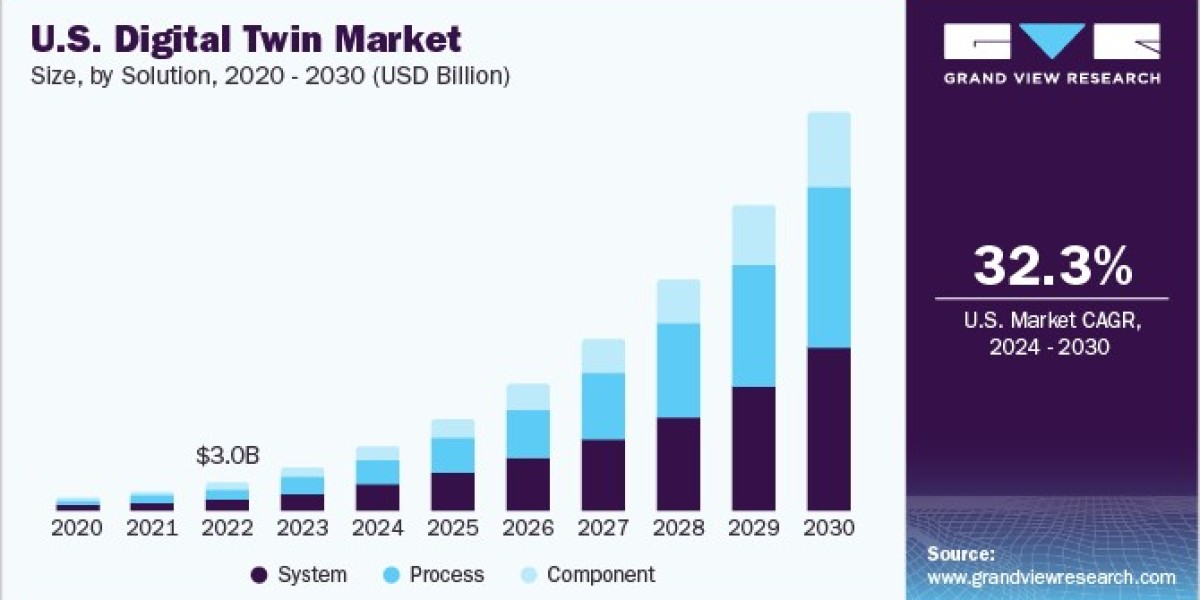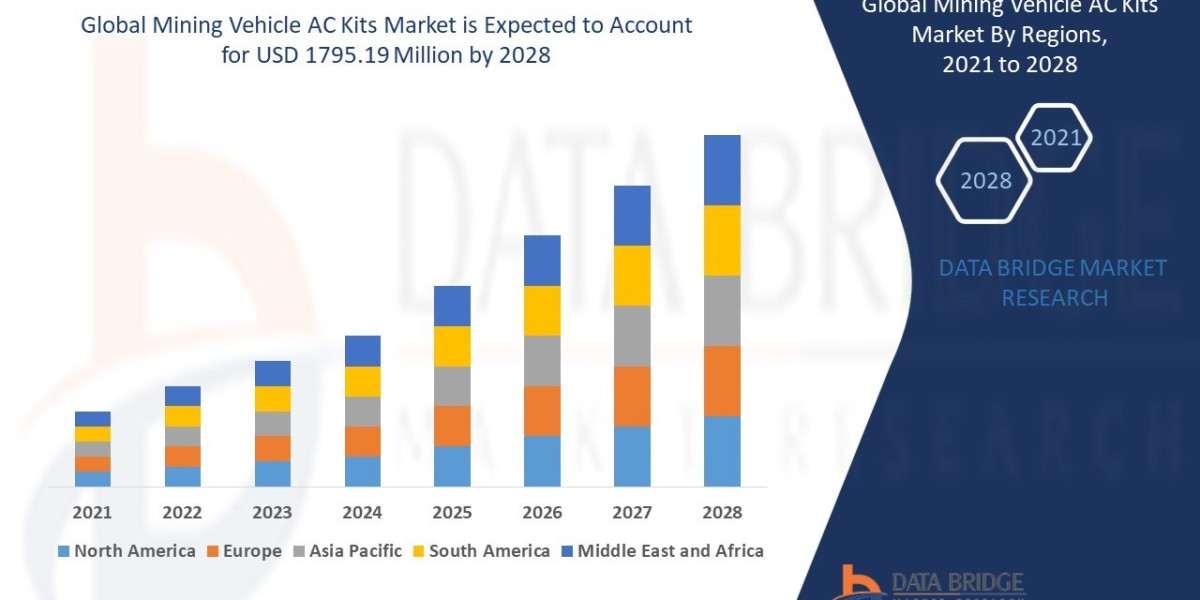The global digital twin market size is projected to reach USD 155.84 billion by 2030, registering a CAGR of 35.7% from 2024 to 2030, according to a new study by Grand View Research Inc. Increasing public and private investments in digital transformation solutions, rising significance of smart factories, and global proliferation of cloud-based platforms are collectively contributing to market growth. The digital twin facilitates enterprises to efficiently reduce expenses and increase revenue. Various factors, such as social media, cloud computing, and process automation, also contribute to the use of digital twins to increase process efficiency and propel market expansion.
The emergence of advanced technologies, such as robotic process automation (RPA), the Internet of Things (IoT), artificial intelligence (AI), cloud computing, and big data analytics is creating a positive outlook for the market. Implementing IoT in manufacturing allows electronic devices to communicate with each other without any human interference within a prevailing internet infrastructure. Therefore, IoT could have a profound impact on the digital twin industry. IoT allows connected devices to interact with each other and exchange critical notifications, such as defective or damaged ping, supporting market growth. Several industries have adopted digital twin technology.
Gather more insights about the market drivers, restrains and growth of the Digital Twin Market
Detailed Segmentation:
Market Concentration & Characteristics
Innovation, global competition, and technological advances can be considered key driving factors responsible for market expansion and growth. The digital twin has provided businesses with additional means to cut costs and augment profits effectively. Digital twin providers are anticipated to leverage new technological innovations to manage the time-to-market concerns efficiently, increase the existing system’s productivity, and optimize internal processes, product designs, and systems to reduce energy consumption, enhance the production layout, and minimize investments, among others. Over the past few years, the emergence of technologies, such as Robotic Process Automation (RPA), has started to influence the market.
Solution Insights
The system segment led the market and accounted for around 41.0% of the global revenue share in 2023. The high market share can be attributed to the growing usage of digital twin solutions for developing and designing assembly lines, communication systems, and piping systems in oil & gas, automotive models, and aerospace sectors. System twins are an integration of several assets, which allows engineers to observe and interpret the synchronization of components during operation and system performance, supporting segment growth.
Deployment Insights
The on-premise deployment segment accounted for the largest revenue share in 2023 due to the high adoption of on-premise solutions by large enterprises for enhanced security and ease of compliance with government regulations. Furthermore, large enterprises have critical business information, and to protect it, these enterprises choose complete ownership of solutions. However, lately, consumer focus is shifting toward cloud-based solutions owing to their easy operation and low operating costs. Therefore, the on-premise segment is expected to witness slow growth during the forecast period.
Enterprise Size Insights
The large enterprises segment accounted for the largest revenue share in 2023. The high market share can be attributed to the increasing use of digital twins by large enterprises to reduce the product time to market and enhance product performance. The digital twin offers end-to-end visibility on the product and its operations, which assists these organizations in planning the maintenance of the machinery, supporting the segment growth.
Application Insights
The predictive maintenance segment accounted for the largest revenue share in 2023. With the help of digital twin in predictive maintenance, engineers can determine and schedule the maintenance preventing machine failure by enabling scheduled maintenance as per actual need and reducing downtime. Businesses can leverage digital twins in their predictive maintenance to address various performance issues without under or over-investing in critical resources.
End-use Insights
The automotive & transport end-use segment accounted for the largest revenue share of around 21.0% in 2023. The high market share can be attributed to the growing adoption of digital twins in this sector due to its various benefits, such as cost optimization, enhanced safety of vehicles, and high productivity. Digital twin technology can assist manufacturers and operators in making better decisions about how to design, operate, and maintain vehicles, as well as improve the supply chain by providing real-time data and insights. Real-time vehicle health monitoring can be performed with the help of digital twin technology, which also aids in anticipating maintenance requirements and planning them accordingly.
Regional Insights
North America region dominated the market and accounted for a share of around 34.0% in 2023. The regional growth can be attributed to the emergence of technologies, such as Robotic Process Automation (RPA), Virtual Reality (VR), and the IoT, which has started to influence the digital twin industry. Key companies in the U.S., such as International Business Machines Corporation, Microsoft Corporation, and General Electric, are effectively working on new product development and enhancement of existing products to acquire customers and capture more market shares.
Browse through Grand View Research's Next Generation Technologies Industry Research Reports.
• The global generative AI coding assistants market size was estimated at USD 18.6 million in 2023 and is projected to grow at a CAGR of 25.8% from 2024 to 2030.
• The global IoT platform market size was estimated at USD 11.10 billion in 2023 and is projected to grow at a CAGR of 12.7% from 2024 to 2030.
Key Digital Twin Company Insights
Some of the key players operating in the market include ABB Group; International Business Machines Corporation; Microsoft Corporation; and Rockwell Automation.
• ABB Group is a technology company that aids in the transformation of industry and society toward a productive and sustainable future. ABB operates its business through four business areas, namely Electrification, Process Automation, Motion, and Robotics & Discrete Automation. The Robotics & Discrete Automation segment offers industrial robots, software, robotic solutions and systems, field services, spare parts, and digital services
• International Business Machines Corporation is a global Information Technology (IT) company that provides software and solutions for digital technologies. The services offered by the company include business process & operations, cloud services, digital workplace services, technology support services, business resilience services, network services, application services, and security services.The company has several fully owned subsidiaries, such as WTC Insurance Corporation, Ltd.; IBM Canada Limited; IBM Global Financing Denmark ApS; IBM Egypt Business Support Services; International Business Machines Gabon SARL; PT IBM Indonesia; International Business Machines Madagascar SARLU; and Companhia IBM Portuguesa, S.A.; among others
Key Digital Twin Companies:
The following are the leading companies in the digital twin market. These companies collectively hold the largest market share and dictate industry trends.
• ABB Group
• Amazon Web Services, Inc.
• ANSYS, Inc.
• Autodesk Inc.
• AVEVA Group plc
• Bentley Systems Inc.
• Dassault Systemes
• General Electric
• Hexagon AB
• International Business Machines Corporation
• Microsoft Corporation
• PTC Inc.
• Robert Bosch GmbH
• Rockwell Automation
• SAP SE
• Siemens AG
Digital Twin Market Segmentation
Grand View Research has segmented the global digital twin market on the basis of solution, deployment, enterprise size, application, end-use, and region:
Digital Twin Solution Outlook (Revenue, USD Billion, 2018 - 2030)
• Component
• Process
• System
Digital Twin Deployment Outlook (Revenue, USD Billion, 2018 - 2030)
• Cloud
• On-premise
Digital Twin Enterprise Size Outlook (Revenue, USD Billion, 2018 - 2030)
• Large Enterprises
• Small and Medium Enterprises (SMEs)
Digital Twin Application Outlook (Revenue, USD Billion, 2018 - 2030)
• Product Design & Development
• Predictive Maintenance
• Business Optimization
• Others
Digital Twin End-use Outlook (Revenue, USD Billion, 2018 - 2030)
• Manufacturing
• Agriculture
• Automotive & Transport
• Energy & Utilities
• Healthcare & Life Sciences
• Residential & Commercial
• Retail & Consumer Goods
• Aerospace
• Telecommunication
• Others(Aerospace & Defense, Mining, Financial Services)
Digital Twin Regional Outlook (Revenue, USD Billion, 2018 - 2030)
• North America
o U.S.
o Canada
• Europe
o UK
o Germany
o France
• Asia Pacific
o India
o China
o Japan
o Australia
o South Korea
• Latin America
o Brazil
o Mexico
• Middle East & Africa (MEA)
o UAE
o Saudi Arabia
o South Africa
Order a free sample PDF of the Digital Twin Market Intelligence Study, published by Grand View Research.
Recent Developments
• In January 2024, Valeo, an automotive technology provider, partnered with Applied Intuition, a vehicle software supplier, to provide a digital twin platform for advanced driver-assistance systems (ADAS) sensor simulation. OEMs would be able to bring reliable and safe ADAS features to market faster with the joint solution
• In April 2023, Rockwell Automation installed a Robotic Supervision System (RSS) for TotalEnergies. RSS combines the Internet of Things (IoT), gamification, and digital twin technology to improve industrial robot management and monitoring. The system aims to maximize robot performance, upkeep, and productivity, reflecting the continued growth of manufacturing automation and digital technologies in the renewable energy sector
• In March 2023, WSP collaborated with Amazon Web Services, Inc. to develop digital twins for complex infrastructure. The collaboration intends to leverage Amazon Web Services, Inc.'s cloud data processing and analytics services to drive innovation and long-term solutions across several industries. It aims to utilize Amazon Web Services, Inc.’s technology to improve WSP's services in areas, such as planning for infrastructure, environmental sustainability, and data-driven choices



